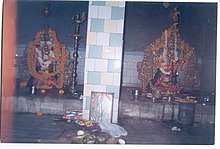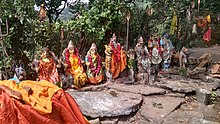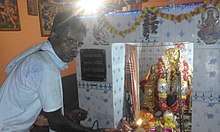Village deities of South India
Village deities are the numerous spirits and other beings venerated as part of the folk tradition in villages throughout South India. They are found in almost all villages in Tamil, Kannada and Telugu-speaking areas. These deities, mainly goddesses, are intimately associated with the well-being of the village and can have either benevolent or violent tendencies.

These deities have been linked back to common Indus Valley civilization imagery, and could represent the prevailing Dravidian folk religion at the time. The worship of these gods at many times contradicts the common tenents of Brahminical traditions, especially animal sacrifice, right of priesthood, and possession. Today these deities are worshipped by almost all non-Brahmins in the rural areas of Tamil Nadu, Telangana, Andhra Pradesh and Karnataka. Similar practices, more influenced by Brahminical practices, are still found in Indo-Aryan peoples, especially those of Maharashtra, West Bengal and Bihar.
Origins and history
Most scholars see the village deities of South India as continuations of religious traditions followed in the subcontinent before the arrival of Indo-Aryans. In the early centuries BCE, village goddesses are represented with various symbols such as the chakra (wheel), srivatsa (an unending knot), and trishula (trident), all of which have parallels in the Indus Valley civilization. It thus seems likely that the worship of these village deities was also present in the Indus Valley civilization at some point. In the Deccan Plateau, the first art forms for the fertility goddess appeared between the 8th and 4th century BCE, before the recorded arrival of other traditions like Buddhism, Jainism and Brahminism into the region.[1]
Types
There are three main types of deity propitiated in a village. Any of these deities can be considered a kuladevata.

All villages will have a fertility goddess. This goddess is believed to arise from the natural world itself and to be intrinsically linked to the ground of the village. She is a representation of the village itself, rather than simply a guardian figure. She often has the additional responsibility of overseeing rain, since, in the areas of South India east of the Western Ghats, the monsoon rains are the primary source of water for agriculture. She is the main protector of the village, especially against common diseases like smallpox or plague. Other goddesses preside over specific household objects, or act as guardians of cattle or children.[1] Most of these deities are unique to their village and have their own origin stories, and many are worshipped only by members of a particular community. Mariamman is one of the most popular of this class of deity, worshipped throughout South India. She provides fertility and, in many places, protection against smallpox and other deadly diseases. Other popular goddesses include Pochamma in Telugu regions and Yellamma in northern Karnataka and western Telangana. Another common theme is the seven sisters, called saptamatrikas in Brahminical traditions. This collection of goddesses does not have a specific function, but may be called upon if a disease is affecting the family. In the area around Tirumala, it is said that these deities can be seen as young girls wandering around at noon, dusk or night.[1] Village goddesses can have different personalities. Some are kindly, and will shower blessings on those who worship them. Others are vengeful and angry, and will unleash terror on the village unless they are propitiated. Many of these deities are especially worshipped by one particular community, for example Yellamma is worshipped especially by two Dalit communities: Malas and Madigas.[2]

Villages, especially in Tamil and Telugu regions, will also have a guardian deity: a male deity who protects the village from harms like war or famine or other evils. Unlike the fertility goddess, this deity is worshipped throughout a wide region and has less variety. In Tamil Nadu, this deity is called Aiyyanar, while in Telugu, he is known as Poturaju and is the brother of the presiding goddess. A common origin myth for Poturaju is that he drank the blood of demons slain by amma. In Tamil Nadu, there are a host of other male deities, such as Karuppusami, who are either attendants to Aiyanar or guardians for the main goddess. Others are the kuladevatas for a particular family or community, especially those of dominant castes. For example: Beerappa is the most prominent kuladevata for Kuruba families in Karnataka.
Occasionally, the fertility goddess or guardian deity can be the spirit of a real person. This group includes anyone who died and whose spirit was later worshipped and propitiated. Formerly those men who died a heroic death were worshipped at special hero stones, known as natukal or viragal, in Tamil Nadu and Karnataka. Similar to hero stones, sati stones honour women who sacrificed their life, especially for chastity and purity. The early Tamil poem Tolkappiyam gives a six-stage guide to the erection of such a stone, from selection of a suitable stone until the institution of formal worship. In time these nadukals became Ayyanar shrines. Examples of deified heroes include Madurai Veeran (from Madurai) and Kaathavarayan (who lived near Thanjavur). Oftentimes, these heroes are found as attendants to Ayyanar or a village goddess, especially in Tamil Nadu. The Paanchamman temples in north Tamil Nadu were built to worship widows who underwent Sati. Often, the deities are spirits who suffered injustice in their lives or deaths and must be propitiated to prevent their spirit from affecting the village.[2] Several couples who have lost their lives due to caste are worshipped as deities in several villages. Kannagi from the Silappadikaram, whose husband was unjustly killed by the Pandyan king, is another widely-worshipped deity of this category. The Maachani Amman temple at Pollachi was built to worship a young girl who was killed by a Kongu king for unknowingly eating a mango from his garden. Oftentimes female spirits are merged into the main fertility goddess, or are venerated as one of her attendants.
Some few deities are less-venerated characters in the epics of the Ramayana and Mahabharata. For example, there are many temples dedicated to Draupadiamman (Panchali) and Dharmaraja (Yudhishthira) in northern Tamil Nadu. Temples dedicated to Gandhari (mother of the Kauravas), Kunti (mother of Pandavas) and Aravan (the son of Arjuna and the serpent princess Ulupi) are also found in Tamil Nadu.
Representation and worship
The place and way in which a deity is represented is symbolic of their role in society. In Tamil Nadu, the guardian god is given a space along the village boundaries to protect them from harm, but the fertility goddess is normally given the center of attention in the middle of the village. The shrines themselves vary by deity and region. For Tamils, Aiyanar is represented in an open space to better fulfill his duty. However there the goddess is given her own temple similar in form, and sometimes size, to a Brahminical temple.[2] In other regions, however, the goddess (since gods are less venerated in these areas) may be given a shrine at the edge of the village, although it is common to find the shrine next to a tree or a snake-hole. In Telugu regions, the deity sometimes has no permanent shrine, but a temporary pandal. Some goddesses wish to be in the open space to feel the same hardships as their devotees.[3]
The deities themselves are often represented as aniconic, either as a shapeless stone or tree or snake-hole.[1] In Tamil Nadu, the guardian god is often given form as a fierce warrior, holding an aruval or other weapon, with attendants surrounding him. However Poturaju in Telugu areas is typically represented only by a stick in the ground. In Telugu and Kannada regions, the goddess is often given anthropomorphic form as a terracotta statue only during a temple festival, and is then returned to her aniconic shape. In many villages in Tamil Nadu, a village god is represented by planting spears or trishulas in the ground to represent his martial prowess. In the village of Kogilu near Bengaluru, the goddesses were represented by items such as a lamp or a stone pillar. In many areas of South Karnataka, the village goddess is symbolized by an aarti, a lamp made of rice flour shaped like a cone and adorned with kumkuma in the shape of a face.[2]

Another common symbol is the snake, or naga. Usually they are carved onto stone pillars, either in the shape of a hooded cobra (like Adishesha) or as two snakes intertwined. The snake is symbolic of the earth's fertility, since they are only visible after the monsoon, and as a punisher of those who oppose the goddess. Worship of these specific qualities is done in Kerala, especially by non-Brahminical castes such as the Nairs.

There are a huge diversity of worship practices for these deities, oftentimes depending on the deity's nature and other local customs. However, some general characteristics of worship include local language and, most of the time, non-Brahmin priests. Depending on the temper of the deity, they may be offered animal sacrifices or vegetarian offerings. Oftentimes someone, usually from one of the Dalit communities, is possessed by the goddess, and devotees can ask her questions and sometimes criticize her.[3]
During the recent decade or so the Jathara (Thiru Vizha in Tamizh or Festival in English) of Sammakka Saralamma the village deities in the Telangana has become very popular among the locals, which is now in fact the largest tribal festival in the world. Many Telugus and the neighbouring Marathis worship the village deities of Sammakka and Saralamma.[4][5]
During Tamil month of chitirai, AYYALAMAN festival is celebrated in melachinthamani, geethapuram and other 5 villages. During that time on 2nd Tuesday of the month kapu kattu will takes place and from 3rd Wednesday goddess will come on different vahana (animals as vehicles) and on 4th Tuesday of the month, the main event ther(chariot) festival will be conducted which will be continuously moving to all the seven village from Tuesday to friday.on that time people will cut the head of goat and let the blood before ther(chariot) this goat is sacrificed for santhana karupusami who gave place for goddess, when she came from Kerala. And event like therta kudam, flower pallaku, kuthu will be conducted then next Tuesday manjal ner (yellow water) will be celebrated. Then goddess will go back to her temple situated on outskirts of the village. This festival of Ayyalaman will continue for a month nearly 30 days.
During the Tamil month of Masi and Panguni, Kulumayee Amman Festival is celebrated in Puthur and Sholnganallur villages in Tiruchi District of Tamil Nadu. During that time Marulali of the respective village suck the blood of the Goats with the blessings of Ondi Karuppu. During the Tamil Months of Karthikai (Sokka Paanai during Karthigai Dheepam); Thai (Thai poosam, Makar Jyothi of Ayyappan); Masi (Masi Kalari - Shivarathiri); Panguni (Panguni Uthiram considered as the auspicious birthday of Ayyanar); Aadi (Aadi Perukku) and Vaigasi (Vaigasi Visakam), festivals will be conducted in these temples. Generally, a mass convention assembly of large number of related family member gathering is organized during the spring season for a period of 2 to 3 days. For the annual mass convention festival, the tradition is that the commencement of the festival will be with that of a hoisting of the flag and tying "Kappu." After this time, villagers neither can go out of the village to different village or come into the village from a different village.
People who always had greater belief in God agreed with the decisions that was taken by the committee members. More importantly, it is the belief of the village people that the Karuppu samy God is being disguised in the form of the man who predicts the future. This belief system about Karuppu samy is called the "Arul vaaku" in several parts of Tamil Nadu. The social issues will be discussed through the temple fore-tellers (Kodangi) whom the people usually consider as the voice of the Karuppa sami deity. When Lord Karuppa sami addresses the people in different villages through Kodangi, different issues and dimensions on social, cultural and psychological aspects of people and society are reviewed for possible solutions.
Worship of Goddess ANKAMMA: Ankamma is also known as Angamma, Ankalamma, Angalamma, Ankali, Angali, Ankala Parameswari, Angala Parameswari. She is worshipped with these names in Andhra, Karnataka, Tamil Nadu. Ankali and Kali are one and the same goddess. Ankamma is considered to be the mother of Trimurtis. The most important part of Ankamma Kolupu is that a midnight puja was performed with the help of ballads by making a colorful Rangoli with wheat flour, turmaric powder, kumkum, black charcoal powder, etc. At the end of the puja, the devotees sacrifice a goat. The devara kolupu / veerla kolupu is normally performed on some special occasions by individuals or by community as a whole. During the worship singers recite historical stories about warrior ancestors.
Relationship with Brahminical Hinduism
The Vedic and non-Vedic people assimilated from each other. Even though there are diversified characteristics between the Vedic and the folk tradition, various communities inducted these deities in their spectrum and created various sthalapuranas which emphasized the relation between these gods and goddesses from differing traditions. For example, a male deity called Kuttandavar is worshipped in many parts of the Tamil country, especially in South Arcot district. The image consists of a head like a big mask with a fierce face and lion's teeth projecting downwards outside the mouth. According to legend the creation of Kuttandavar, the god Indra, is for the crime of murdering a Brahmin, became incarnated in the form of Kuttandavar, and a curse was laid upon him that his body leaving only the head. Another story, from Chittoor district, is about the goddess Gangamma, who was the daughter of a Brahmin who unknowingly married a Dalit. This Dalit had claimed Brahmin status in order to lean from the Brahmin, but was unknowingly exposed by his mother who had visited. Ganga, distraught at being "polluted," burned herself to death, and her angry spirit cursed her husband and his mother to be reborn as a goat and sheep respectively, and to be sacrificed to her for all eternity. This myth, by vilifying the Dalits as nothing more than animals and portraying the Brahmins as innocent victims, is meant to show the "disastrous consequences" of transgressing one's caste and to uphold caste boundaries. This is one example of Brahminical influences on the folk traditions.
The popular deities have evolved significantly over time. For example, Mariamman, another traditional folk deity, is highly influenced by the Vedic rituals. She is usually garlanded with skulls. But due to Vedic influence, the skull garland has been replaced by the lemon garland and her poor outlook has been altered into a pleasant one. Sometimes these processes of assimilation lead to the degradation of the deities. When the Brahmins stressed the holiness of the Brahminical deities, at the same time they denied the holiness of the deities of the folk tradition. They described the gods and goddesses of folk tradition either as subservient to Brahminical deities or they venerated these deities as capable of curing most potent contagious diseases.
The process of inclusivism can also be seen in popular temples dedicated to the deities of folk religion. For example, the increase in the number of devotees to Samayapuram, Punnainallur, Vazhangaiman Mariamman temples in Tamil Nadu boosted the financial position. It attracts Brahmins to switch over their interest to Mariamman on account of the financial benefits. They not only dominate during the time of worship, but also on various other occasions. They have introduced the custom of Kumbhabhishekam. In addition to this, they have made Mariamman as a Suddhadevatas (vegetarian deity). With regard to the temples of folk tradition Vinayakar, Murugan, Iyyappan and others, Vedic deities are replaced by the deities of folk tradition such as Aiyanar, Madurai Veeran and Karuppannasamy. Even the people of the folk tradition have begun to follow some customs and habits of higher castes in order to raise their social status.
See also
- Muruga
- Urumi - a Folk musical instrument used in festivals and as an instrument of getting into trance.
- Veeramanidasan - popular Tamil devotional singer.
- Village deities of Sri Lankan Tamils
References
- Padma, Sree (11 October 2013). Vicissitudes of the Goddess. Oxford University Press. ISBN 978-0-19-932502-3.
- Whitehead, Henry, 1853-1947. (1916). The village gods of south India. London,: H. Milford, Oxford University Press. ISBN 0-524-02678-5. OCLC 636168782.CS1 maint: extra punctuation (link) CS1 maint: multiple names: authors list (link)
- Ch, Prof; Ch, an GowdaProf; Jan 16, an Gowda / Updated:; 2016; Ist, 04:00. "The World of Village Goddesses". Bangalore Mirror. Retrieved 20 July 2020.CS1 maint: extra punctuation (link) CS1 maint: numeric names: authors list (link)
- http://www.indiamike.com/india/hyderabad-f139/andhra-pradesh-hosts-worlds-largest-tribal-festival-t100949/
- Sammakka Saralamma Jatara
| Wikimedia Commons has media related to Hinduism in Tamil Nadu. |
